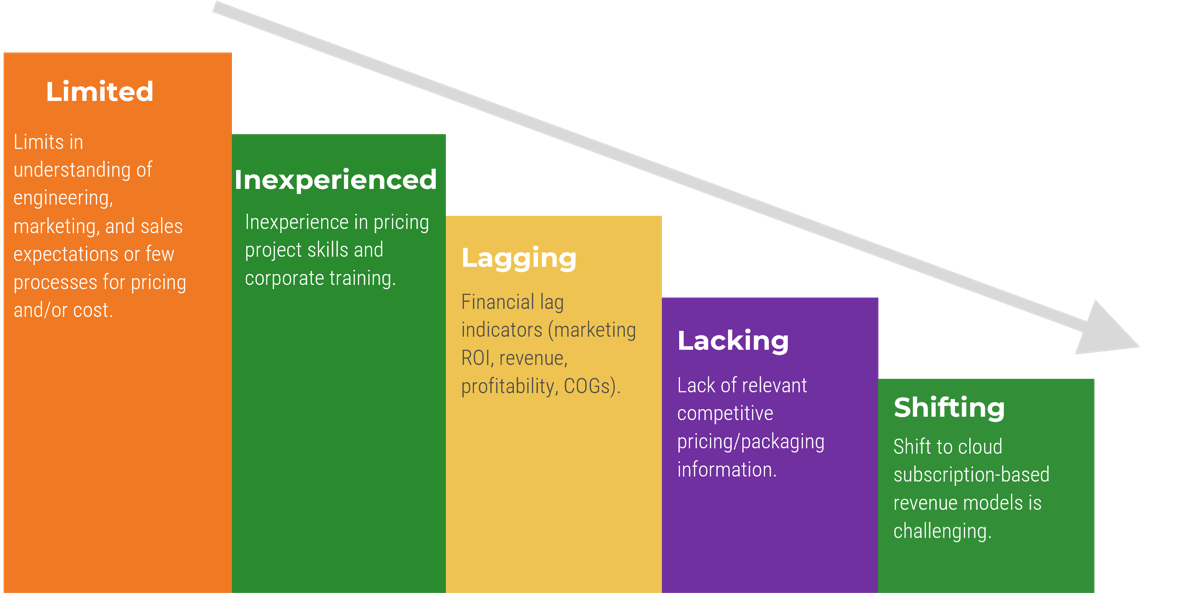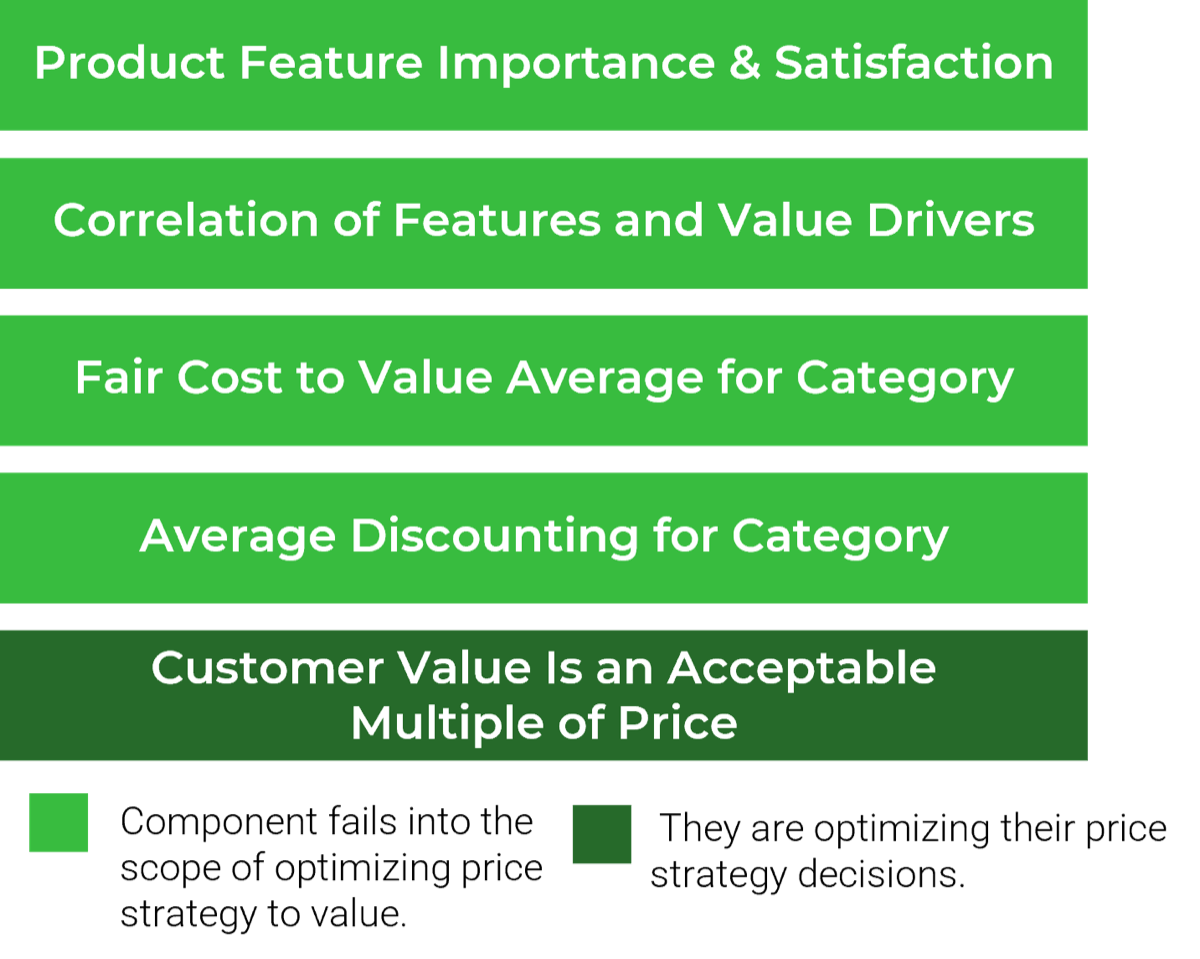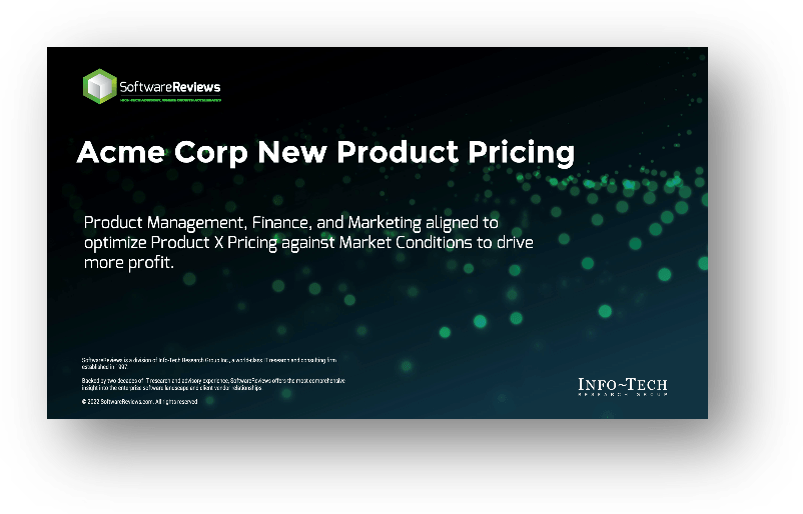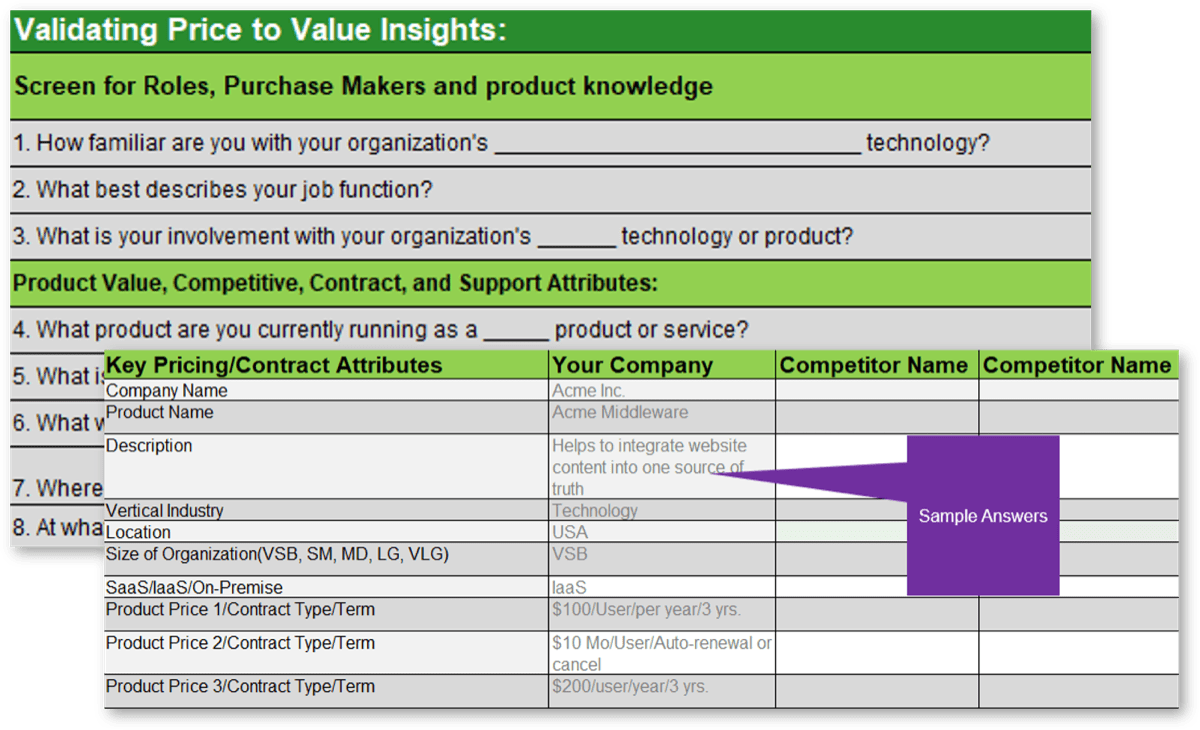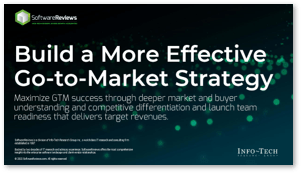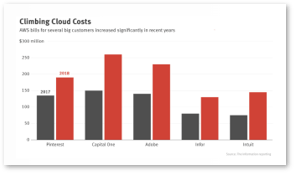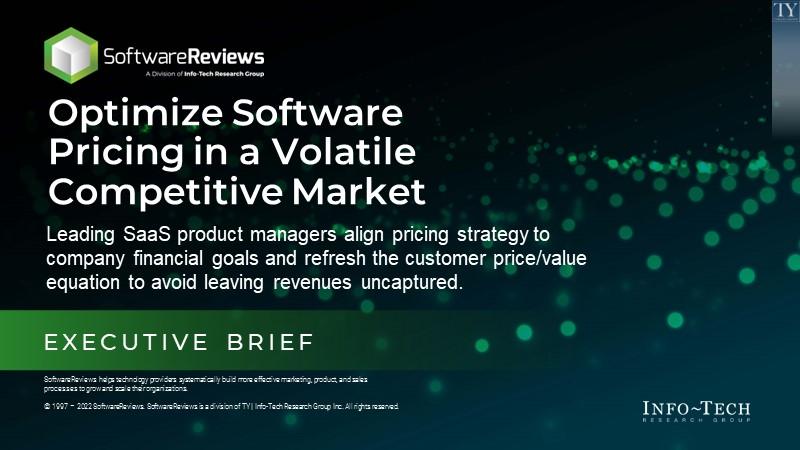
Optimize Software Pricing in a Volatile Competitive Market
Your challenge:
- Rising supplier costs and inflation are eroding margins and impacting customers' budgets.
- There is pressure from management to make a gut-feeling decision because of time, lack of skills, and process limitations.
- You must navigate competing pricing-related priorities among product, sales, and finance teams.
- Product price increases fail because discovery lacks understanding of costs, price/value equation, and competitive price points.
- Customers can react negatively, and results are seen much later (more than 12 months) after the price decision.
Our Advice
Critical Insight
Product leaders will price products based on a deep understanding of the buyer price/value equation and alignment with financial and competitive pricing strategies, and make ongoing adjustments based on an ability to monitor buyer, competitor, and product cost changes.
Impact and Result
- Success for many SaaS product managers requires a reorganization and modernization of pricing tools, techniques, and assumptions. Leaders will develop the science of tailored price changes versus across-the-board price actions and account for inflation exposure and the customers’ willingness to pay.
- This will build skills on how to price new products or adjust pricing for existing products. The disciplines using our pricing strategy methodology will strengthen efforts to develop repeatable pricing models and processes and build credibility with senior management.
Optimize Software Pricing in a Volatile Competitive Market Research & Tools
Besides the small introduction, subscribers and consulting clients within this management domain have access to:
1. Optimize Software Pricing in a Volatile Competitive Market Executive Brief - A deck to build your skills on how to price new products or adjust pricing for existing products.
This Executive Brief will build your skills on how to price new products or adjust pricing for existing products.
- Optimize Software Pricing in a Volatile Competitive Market Executive Brief
2. Optimize Software Pricing in a Volatile Competitive Market Storyboard – A deck that provides key steps to complete the project.
This blueprint will build your skills on how to price new products or adjust pricing for existing products with documented key steps to complete the pricing project and use the Excel workbook and customer presentation.
- Optimize Software Pricing in a Volatile Competitive Market – Phases 1-3
3. Optimize Software Pricing in a Volatile Competitive Market Workbook – A tool that enables product managers to simplify the organization and collection of customer and competitor information for pricing decisions.
These five organizational workbooks for product pricing priorities, interview tracking, sample questions, and critical competitive information will enable the price team to validate price change data through researching the three pricing schemes (competitor, customer, and cost-based).
- Optimize Software Pricing in a Volatile Competitive Market Workbook
4. Optimize Software Pricing in a Volatile Competitive Market Presentation Template – A template that serves as a guide to communicating the Optimize Pricing Strategy team's results for a product or product line.
This template includes the business case to justify product repricing, contract modifications, and packaging rebuild or removal for launch. This template calls for the critical summarized results from the Optimize Software Pricing in a Volatile Competitive Market blueprint and the Optimize Software Pricing in a Volatile Competitive Market Workbook to complete.
- Optimize Software Pricing in a Volatile Competitive Market Presentation Template
Infographic
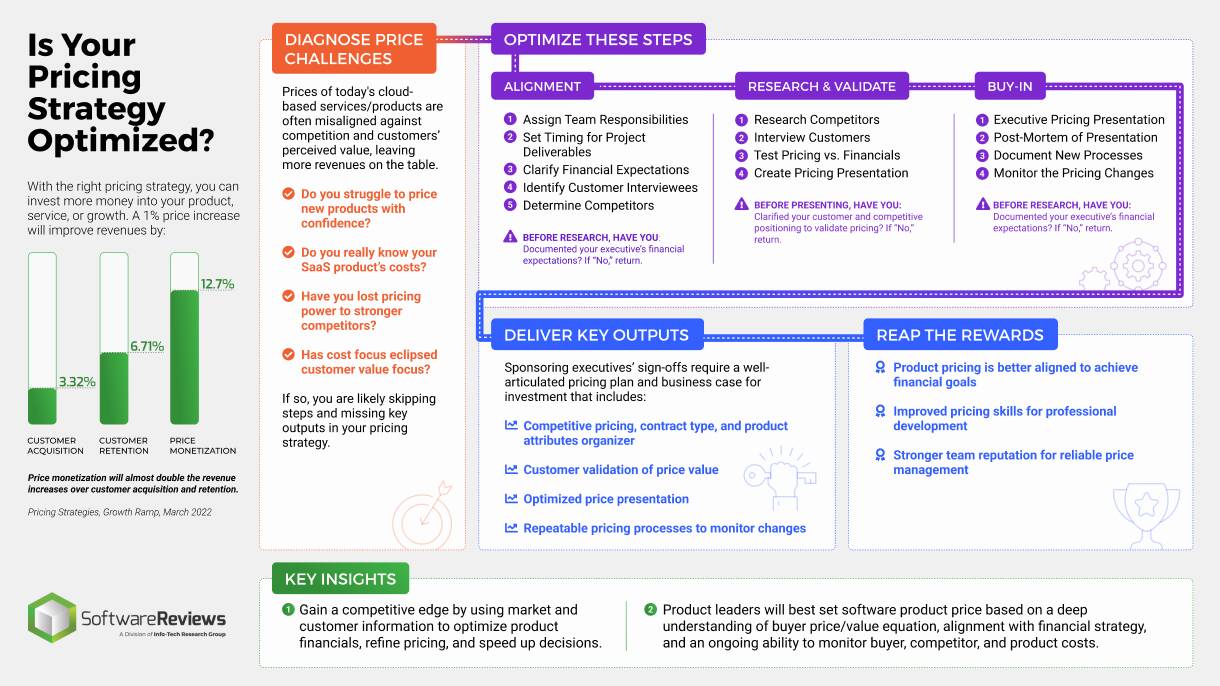
Further reading
SoftwareReviews — A Division of INFO~TECH RESEARCH GROUP
Optimize Software Pricing in a Volatile Competitive Market
Leading SaaS product managers align pricing strategy to company financial goals and refresh the customer price/value equation to avoid leaving revenues uncaptured.
Table of Contents
Optimize Software Pricing in a Volatile Competitive Market
Leading SaaS product managers align pricing strategy to company financial goals and refresh the customer price/value equation to avoid leaving revenues uncaptured.
EXECUTIVE BRIEF
Analyst Perspective
Optimized Pricing Strategy
Product managers without well-documented and repeatable pricing management processes often experience pressure from “Agile” management to make gut-feel pricing decisions, resulting in poor product revenue results. When combined with a lack of customer, competitor, and internal cost understanding, these process and timing limitations drive most product managers into suboptimal software pricing decisions. And, adding insult to injury, the poor financial results from bad pricing decisions aren’t fully measured for months, which further compounds the negative effects of poor decision making.
A successful product pricing strategy aligns finance, marketing, product management, and sales to optimize pricing using a solid understanding of the customer perception of price/value, competitive pricing, and software production costs.
Success for many SaaS product managers requires a reorganization and modernization of pricing tools, techniques, and data. Leaders will develop the science of tailored price changes versus across-the-board price actions and account for inflation exposure and the customers’ willingness to pay.
This blueprint will build your skills on how to price new products or adjust pricing for existing products. The discipline you build using our pricing strategy methodology will strengthen your team’s ability to develop repeatable pricing and will build credibility with senior management and colleagues in marketing and sales.

|
Joanne Morin Correia
|
Executive Summary
Organizations struggle to build repeatable pricing processes:
|
Obstacles add friction to the pricing management process:
|
Use SoftwareReviews’ approach for more successful pricing:
|
SoftwareReviews Insight
Product leaders will price products based on a deep understanding of the buyer price/value equation and alignment with financial and competitive pricing strategies, and they will make ongoing adjustments based on an ability to monitor buyers, competitors, and product cost changes.
What is an optimized price strategy?
| “Customer discovery interviews help reduce the chance of failure by testing your hypotheses. Quality customer interviews go beyond answering product development and pricing questions.” (Pricing Strategies, Growth Ramp, March 2022)
Most product managers just research their direct competitors when launching a new SaaS product. While this is essential, competitive pricing intel is insufficient to create a long-term optimized pricing strategy. Leaders will also understand buyer TCO. Your customers are constantly comparing prices and weighing the total cost of ownership as they consider your competition. Why? Implementing a SaaS solution creates a significant time burden as buyers spend days learning new software, making sure tools communicate with each other, configuring settings, contacting support, etc. It is not just the cost of the product or service. |
Optimized Price Strategy Is…
|
Price Strategy Is Not…
|
SoftwareReviews Insight
An optimized pricing strategy establishes the “best” price for a product or service that maximizes profits and shareholder value while considering customer business value vs. the cost to purchase and implement – the total cost of ownership (TCO).
Challenging environment
Product managers are currently experiencing the following:
|
Doing nothing is NOT an option!
|
Pricing skills are declining
| Among product managers, limited pricing skills are big obstacles that make pricing difficult and under-optimized.
|
The top three weakest product management skills have remained constant over the past five years:
|
Key considerations for more effective pricing decisions
Pricing teams can improve software product profitability by:
|
Software pricing leaders will regularly assess:
Has it been over a year since prices were updated? Have customers told you to raise your prices? Do you have the right mix of customers in each pricing plan? Do 40% of your customers say they would be very disappointed if your product disappeared? (Adapted from Growth Ramp, 2021) |
Case StudyMiddleware Vendor |
INDUSTRY
|
SOURCE
|
| A large middleware vendor, who is running on Microsoft Azure, known for quality development and website tools, needed to react strategically to the March 2022 Microsoft price increase.
Key Initiative: Optimize New Pricing Strategy The program’s core objective was to determine if the vendor should implement a price increase and how the product should be packaged within the new pricing model. For this initiative, the company interviewed buyers using three key questions: What are the core capabilities to focus on building/selling? What are the optimal features and capabilities valued by customers that should be sold together? And should they be charging more for their products?Results
|
The Optimize New Pricing Strategy included the following components:
|
New product price approach
| As a collaborative team across product management, marketing, and finance, we see leaders taking a simple yet well-researched approach when setting product pricing.
Iterating to a final price point is best done with research into how product pricing:
|
To arrive at our new product price, we suggest iterating among 3 different views:
New Target Price:
|
Who should care about optimized pricing?Product managers and marketers who:
Finance, sales, and marketing professionals who are pricing stakeholders in:
|
How will they benefit from this research?
|
Is Your Pricing Strategy Optimized?With the right pricing strategy, you can invest more money into your product, service, or growth. A 1% price increase will improv revenues by: 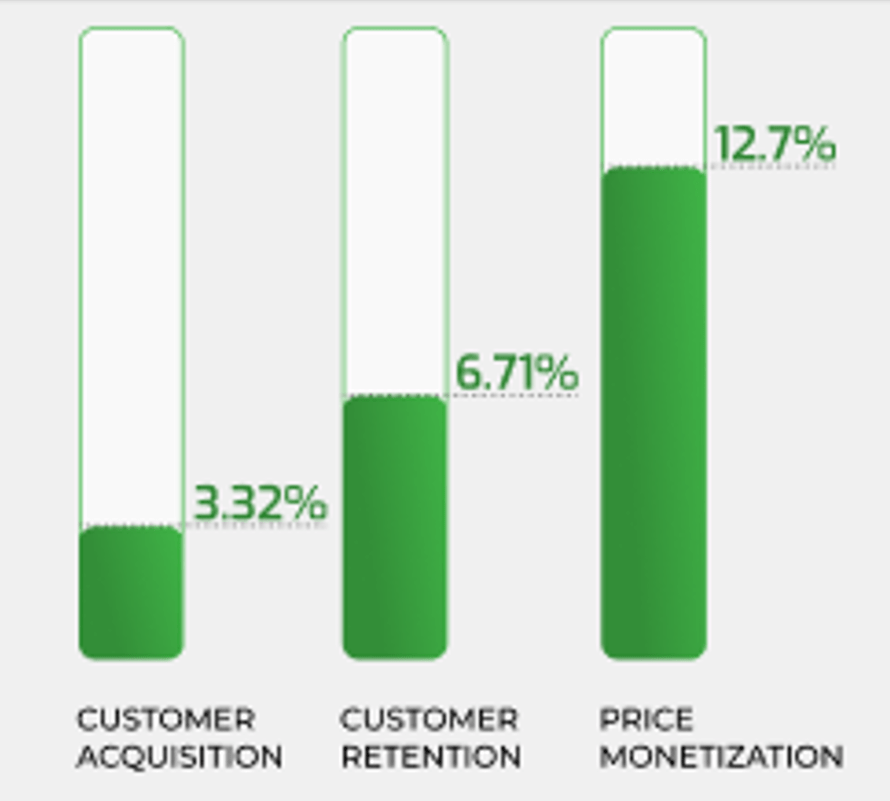
Price monetization will almost double the revenue increases over customer acquisition and retention. (Pricing Strategies, Growth Ramp, March 2022) |
DIAGNOSE PRICE CHALLENGESPrices of today's cloud-based services/products are often misaligned against competition and customers' perceived value, leaving more revenues on the table.
|
|||
OPTIMIZE THESE STEPS
|
||||
|
||||
Key Insights
- Gain a competitive edge by using market and customer information to optimize product financials, refine pricing, and speed up decisions.
- Product leaders will best set software product price based on a deep understanding of buyer/price value equation, alignment with financial strategy, and an ongoing ability to monitor buyer, competitor, and product costs.
SoftwareReviews’ methodology for optimizing your pricing strategy
Steps |
1.1 Establish the Team and Responsibilities
1.2 Educate/Align Team on Pricing Strategy 1.2 Document Portfolio & Target Product(s) for Pricing Updates 1.3 Clarify Product Target Margins 1.4 Establish Customer Price/Value 1.5 Identify Competitive Pricing 1.6 Establish New Price and Gain Buy-In |
Outcomes |
|
Insight summary
Modernize your price planning
Product leaders will price products based on a deep understanding of the buyer price/value equation and alignment with financial and competitive pricing strategies, and make ongoing adjustments based on an ability to monitor buyer, competitor, and product cost changes.
Ground pricing against financialsMeet and align with financial stakeholders.
|
Align on pricing strategyLead stakeholders in SaaS product pricing decisions to optimize pricing based on four drivers:
|
Decrease time for approvalDrive price decisions, with the support of the CFO, to the business value of the suggested change:
|
| Develop the skill of pricing products
Increase product revenues and margins by enhancing modern processes and data monetization. Shift from intuitive to information-based pricing decisions. |
Look at other options for revenue
Adjust product design, features, packaging, and contract terms while maintaining the functionality customers find valuable to their business. |
Blueprint deliverables
Each step of this blueprint is accompanied by supporting deliverables to help you accomplish your goals:Key deliverable:
New Pricing Strategy Presentation TemplateCapture key findings for your price strategy with the Optimize Your Pricing in a Volatile Competitive Market Strategy Presentation Template
|
Optimize Software Pricing in a Volatile Competitive Market Executive BriefThis executive brief will build your knowledge on how to price new products or adjust pricing for existing products.
|
Optimize Software Pricing in a Volatile Competitive Market WorkbookThis workbook will help you prioritize which products require repricing, hold customer interviews, and capture competitive insights.
|
Guided Implementation
A Guided Implementation (GI) is a series of calls with a SoftwareReviews analyst to help implement our best practices in your organization.
A typical GI is 4 to 8 calls over the course of 2 to 4 months.
What does a typical GI on optimizing software pricing look like?
Alignment |
Research & Reprice |
Buy-in |
| Call #1: Share the pricing team vision and outline activities for the pricing strategy process. Plan next call – 1 week.
Call #2: Outline products that require a new pricing approach and steps with finance. Plan next call – 1 week. Call #3: Discuss the customer interview process. Plan next call – 1 week. Call #4 Outline competitive analysis. Plan next call – 1 week. |
Call #5: Review customer and competitive results for initial new pricing business case with finance for alignment. Plan next call – 3 weeks.
Call #6: Review the initial business case against financial plans across marketing, sales, and product development. Plan next call – 1 week. |
Call #7 Review the draft executive pricing presentation. Plan next call – 1 week.
Call #8: Discuss gaps in executive presentation. Plan next call – 3 days. |
SoftwareReviews Offers Various Levels of Support to Meet Your Needs
| Included in Advisory Membership | Optional add-ons | ||
DIY Toolkit |
Guided Implementation |
Workshop |
Consulting |
| "Our team has already made this critical project a priority, and we have the time and capability, but some guidance along the way would be helpful." | "Our team knows that we need to fix a process, but we need assistance to determine where to focus. Some check-ins along the way would help keep us on track." | "We need to hit the ground running and get this project kicked off immediately. Our team has the ability to take this over once we get a framework and strategy in place." | "Our team does not have the time or the knowledge to take this project on. We need assistance through the entirety of this project." |
Desire a Guided Implementation?
- A GI is where your SoftwareReviews engagement manager and executive advisor/counselor will work with SoftwareReviews research team members to craft with you a Custom Key Initiative Plan (CKIP).
- A CKIP guides your team through each of the major steps, outlines responsibilities between members of your team and SoftwareReviews, describes expected outcomes, and captures actual value delivered.
- A CKIP also provides you and your team with analyst/advisor/counselor feedback on project outputs, helps you communicate key principles and concepts to your team, and helps you stay on project timelines.
- If Guided Implementation assistance is desired, contact your engagement manager.
Workshop overview |
Contact your account representative for more information.
|
| Day 1 | Day 2 | Day 3 | Day 4 | Day 5 | |
Align Team, Identify Customers, and Document Current Knowledge |
Validate Initial Insights and Identify Competitors and Market View |
Schedule and Hold Buyer Interviews |
Summarize Findings and Provide Actionable Guidance to Stakeholders |
Present, Go Forward, and Measure Impact and Results |
|
| Activities |
1.1 Identify Team Members, roles, and responsibilities 1.2 Establish timelines and project workflow 1.3 Gather current product and future financial margin expectations 1.4 Review the Optimize Software Executive Brief and Workbook Templates 1.4 Build prioritized pricing candidates hypothesis |
2.1 Identify customer interviewee types by segment, region, etc. 2.2 Hear from industry analysts their perspectives on the competitors, buyer expectations, and price trends 2.3 Research competitors for pricing, contract type, and product attributes |
3.2 Review pricing and attributes survey and interview questionnaires 3.2 Hold interviews and use interview guides (over four weeks) A gap of up to 4 weeks for scheduling of interviews. 3.3 Hold review session after initial 3-4 interviews to make adjustments |
4.1 Review all draft price findings against the market view 4.2 Review Draft Executive Presentation |
5.1 Review finalized pricing strategy plan with analyst for market view 5.2 Review for comments on the final implementation plan |
| Deliverables |
|
|
|
|
|
Our processAlign team, perform research, and gain executive buy-in on updated price points
Optimize Software Pricing in a Volatile Competitive Market |
Our process will help you deliver the following outcomes:
This project involves the following participants:
|
1.0 Assign team responsibilities
Input: Steering committee roles and responsibilities, Steering committee interest and role
Output: List of new pricing strategy steering committee and workstream members, roles, and timelines, Updated Software Pricing Strategy presentation
Materials: Optimize Software Pricing in a Volatile Competitive Market Presentation Template
Participants: CFO, sponsoring executive, Functional leads – development, product marketing, product management, marketing, sales, customer success/support
1-2 hours- The product manager/member running this pricing/repricing program should review the entire Optimize Software Pricing in a Volatile Competitive Market blueprint and each blueprint attachment.
- The product manager should also refer to slide 19 of the Optimize Software Pricing in a Volatile Competitive Market blueprint and decide if help via a Guided Implementation (GI) is of value. If desired, alert your SoftwareReviews engagement manager.
- The product manager should meet with the chief product officer/CPO and functional leaders, and set the meeting agenda to:
- Nominate steering committee members.
- Nominate work-stream leads.
- Establish key pricing project milestones.
- Schedule both the steering committee (suggest monthly) and workstream lead meetings (suggest weekly) through the duration of the project.
- Ask the CPO to craft, outside this meeting, his/her version of the "Message from the chief product officer.”
- If a Guided Implementation is selected, inform the meeting attendees that a SoftwareReviews analyst will join the next meeting to share his/her Executive Brief on Pricing Strategy.
- Record all above findings in the Optimize Software Pricing in a Volatile Competitive Market Presentation Template.
Download the Optimize Software Pricing in a Volatile Competitive Market Presentation Template
SoftwareReviews Advisory Insight:
Pricing steering committees are needed to steer overall product, pricing, and packaging decisions. Some companies include the CEO and CFO on this committee and designate it as a permanent body that meets monthly to give go/no-go decisions to “all things product and pricing related” across all products and business units.
2.0 Educate the team
1 hourInput: Typically, a joint recognition that pricing strategies need upgrading and have not been fully documented, Steering committee and working team members
Output: Communication of team members involved and the makeup of the steering committee and working team, Alignment of team members on a shared vision of “why a new price strategy is critical” and what key attributes define both the need and impact on business
Materials: Optimize Your Software Strategy Executive Brief PowerPoint presentation
Participants: Initiative manager – individual leading the new pricing strategy, CFO/sponsoring executive, Working team – typically representatives in product marketing, product management, and sales, SoftwareReviews marketing analyst (optional)
- Walk the team through the Optimize Software Pricing in a Volatile Competitive Market Executive Brief PowerPoint presentation.
- Optional – Have the SoftwareReviews Advisory (SRA) analyst walk the team through the Optimize Software Pricing in a Volatile Competitive Market Executive Brief PowerPoint presentation as part of your session. Contact your engagement manager to schedule.
- Walk the team through the current version of the Optimize Software Pricing in a Volatile Competitive Market Presentation Template outlining project goals, steering committee and workstream make-up and responsibilities, project timeline and key milestones, and approach to arriving at new product pricing.
- Set expectations among team members of their specific roles and responsibilities for this project, review the frequency of steering committee and workstream meetings to set expectations of key milestones and deliverable due dates.
Download the Optimize Software Pricing in a Volatile Competitive Market Executive Brief
3.0 Document portfolio and target products for pricing update
1-3 HoursInput: List of entire product portfolio
Output: Prioritized list of product candidates that should be repriced
Materials: Optimize Software Pricing in a Volatile Competitive Market Executive Brief presentation, Optimize Software Pricing in a Volatile Competitive Market Workbook
Participants: Initiative manager – individual leading the new pricing strategy, CFO/sponsoring executive, Working team – typically representatives in product marketing, product management, and sales
- Walk the team through the current version of Optimize Software Pricing in a Volatile Competitive Market workbook, tab 2: “Product Portfolio Organizer.” Modify sample attributes to match your product line where necessary.
- As a group, record the product attributes for your entire portfolio.
- Prioritize the product price optimization candidates for repricing with the understanding that it might change after meeting with finance.
Download the Optimize Software Pricing in a Volatile Competitive Market Workbook
4.0 Clarify product target margins
2-3 sessions of 1 Hour each
Input: Finance partner/CFO knowledge of target product current and future margins, Finance partner/CFO who has information on underlying costs with details that illustrate supplier contributions
Output: Product finance markup target percentage margins and revenues
Materials: Finance data on the product family, Optimize Software Pricing in a Volatile Competitive Market Workbook, Optimize Software Pricing in a Volatile Competitive Market Presentation Template
Participants: Initiative manager, Finance partner/CFO
- Schedule a meeting with your finance partner/CFO to validate expectations for product margins. The goal is to understand the detail of underlying costs/margins and if the impacts of supplier costs affect the product family. The information will be placed into the Optimize Software Pricing in a Volatile Competitive Market Workbook on tab 2, Product Portfolio Organizer under the “Unit Margins” heading.
- Arrive at a final “Cost-Plus New Price” based on underlying costs and target margins for each of the products. Record results in the Optimize Software Pricing in a Volatile Competitive Market Workbook, tab 2, under the “Cost-Plus New Price” heading.
- Record product target finance markup price under “Cost-Plus” in Optimize Software Pricing in a Volatile Competitive Market Presentation Template, slide 9, and details in Appendix, “Cost-Plus Analysis,” slide 11.
- Repeat this process for any other products to be repriced.
Download the Optimize Software Pricing in a Volatile Competitive Market Workbook
Download the Optimize Software Pricing in a Volatile Competitive Market Presentation Template
5.0 Establish customer price to value
1-4 weeks
Input: Identify segments within which you require price-to-value information, Understand your persona insight gaps, Review Sample Interview Guide using the Optimize Software Pricing in a Volatile, Competitive Market Workbook, Tab 4. Interview Guide.
Output: List of interviewees, Updated Interview Guide
Materials: Optimize Software Pricing in a Volatile Competitive Market Workbook, Optimize Software Pricing in a Volatile Competitive Market Presentation Template
Participants: Initiative manager, Customer success to help identify interviewees, Customers, prospects
- Identify a list of customers and prospects that best represent your target persona when interviewed. Choose interviewees who will inform key differences among key segments (geographies, company size, a mix of customers and prospects, etc.) and who are decision makers and can best inform insights on price/value and competitors.
- Recruit interviewees and schedule 30-minute interviews.
- Keep track of interviewees using the Optimize Software Pricing in a Volatile Competitive Market Workbook, tab 3: “Interviewee Tracking.”
- Review the Optimize Software Pricing in a Volatile Competitive Market Workbook, tab 4: “Interview Guide,” and modify/update it where appropriate.
- Record interviewee perspectives on the “price they are willing to pay for the value received” (price/value equation) using the Optimize Software Pricing in a Volatile Competitive Market Workbook, tab 4: “Interview Guide.”
- Summarize findings to result in an average “customer’s value price.” Record product target ”customer’s value price” in Optimize Software Pricing in a Volatile Competitive Market Presentation Template, slide 9 and supporting details in Appendix, “Customer Pricing Analysis,” slide 12.
Download the Optimize Software Pricing in a Volatile Competitive Market Workbook
Download the Optimize Software Pricing in a Volatile Competitive Market Presentation Template
6.0 Identify competitive pricing
1-2 weeks
Input: Identify price candidate competitors, Your product pricing, contract type, and product attribute information to compare against, Knowledge of existing competitor information, websites, and technology research sites to guide questions
Output: Competitive product average pricing
Materials: Optimize Software Pricing in a Volatile Competitive Market Workbook, Optimize Software Pricing in a Volatile Competitive Market Presentation Template
Participants: Initiative manager, Customers, prospects
- Identify the top 3-5 competitors’ products that you most frequently compete against with your selected product.
- Perform competitive intelligence research on deals won or lost that contain competitive pricing insights by speaking with your sales force.
- Use the interviews with key customers to also inform competitive pricing insights. Include companies which you may have lost to a competitor in your customer interviewee list.
- Modify and add key competitive pricing, contract, or product attributes in the Optimize Software Pricing in a Volatile Competitive Market Workbook, tab 5: “Competitive Information.”
- Place your product’s information into the Optimize Software Pricing in a Volatile Competitive Market Workbook, tab 5: “Competitive Information.”
- Research your competitors’ summarized pricing and product attribute insights into the workbook.
- Record research in the Summarize research on competitors to arrive at an average “Competitors Avg. Price”. Record in ”Customer’s Value Price” in Optimize Software Pricing in a Volatile Competitive Market Presentation Template, slide 9, and details in Appendix, “Competitor Pricing Analysis,” slide 13.
Download the Optimize Software Pricing in a Volatile Competitive Market Workbook
Download the Optimize Software Pricing in a Volatile Competitive Market Presentation Template
7.0 Establish new price and gain buy-in
2-3 hours
Input: Findings from competitive, cost-plus, and customer price/value analysis
Output: Approvals for price change
Materials: Optimize Software Pricing in a Volatile Competitive Market Presentation Template
Participants: Initiative manager, Steering committee, Working team – typically representatives in product marketing, product management, sales
- Using prior recorded findings of Customer’s Value Price, Competitors’ Avg. Price, and Finance Markup Price, arrive at a recommended “New Price” and record in Optimize Software Pricing in a Volatile Competitive Market Presentation Template, slide 9 and the Appendix for Project Analysis Details.
- Present findings to steering committee. Be prepared to show customer interviews and competitive analysis results to support your recommendation.
- Plan internal and external communications and discuss the timing of when to “go live” with new pricing. Discuss issues related to migration to a new price, how to handle currently low-priced customers, and how to migrate them over time to the new pricing.
- Identify if it makes sense to target a date to launch the new pricing in the future, so customers can be alerted in advance and therefore take advantage of “current pricing” to drive added revenues.
- Confer with IT to assess times required to implement within CPQ systems and with product marketing for time to change sales proposals, slide decks, and any other affected assets and systems.
Download the Optimize Software Pricing in a Volatile Competitive Market Presentation Template
Summary of AccomplishmentProblem SolvedWith the help of this blueprint, you have deepened your and your company’s understanding of how to look at new pricing opportunities and what the market and the buyer will pay for your product. You are among the minority of product and marketing leaders that have thoroughly documented their new pricing strategy and processes – congratulations!The benefits of having led your team through the process are significant and include the following:
|
If you would like additional support, contact us and we’ll make sure you get the professional expertise you need. Contact your account representative for more information. info@softwarereviews.com |
Bibliography
“Chapter 4 Reasons for Project Failure.” Kissflow's Guide to Project Management. Kissflow, n.d. Web.
Edie, Naomi. “Microsoft Is Raising SaaS Prices, and Other Vendors Will, Too.” CIO Dive, 8 December 2021. Web.
Gruman, Galen, Alan S. Morrison, and Terril A. Retter. “Software Pricing Trends.” PricewaterhouseCoopers, 2018. Web.
Hargrave, Marshall. “Example of Economic Exposure.” Investopedia, 12 April 2022. Web.
Heaslip, Emily. “7 Smart Pricing Strategies to Attract Customers.” CO—, 17 November 2021. Web.
Higgins, Sean. “How to Price a Product That Your Sales Team Can Sell.” HubSpot, 4 April 2022. Web.
“Pricing Strategies.” Growth Ramp, March 2022. Web.
“Product Management Skills Benchmark Report 2021.” 280 Group, 9 November 2021. Web.
Quey, Jason. “Price Increase: How to Do a SaaS Pricing Change in 8 Steps.” Growth Ramp, 22 March 2021. Web.
Steenburg, Thomas, and Jill Avery. “Marketing Analysis Toolkit: Pricing and Profitability Analysis.” Harvard Business School, 16 July 2010. Web.
“2021 State of Competitive Intelligence.” Crayon and SCIO, n.d. Web.
Valchev, Konstantin. “Cost of Goods Sold (COGS) for Software-as-a-Service (SaaS) Business.” OpenView Venture Partners, OV Blog, 20 April 2020. Web.
“What Is Price Elasticity?” Market Business News, n.d. Web.
